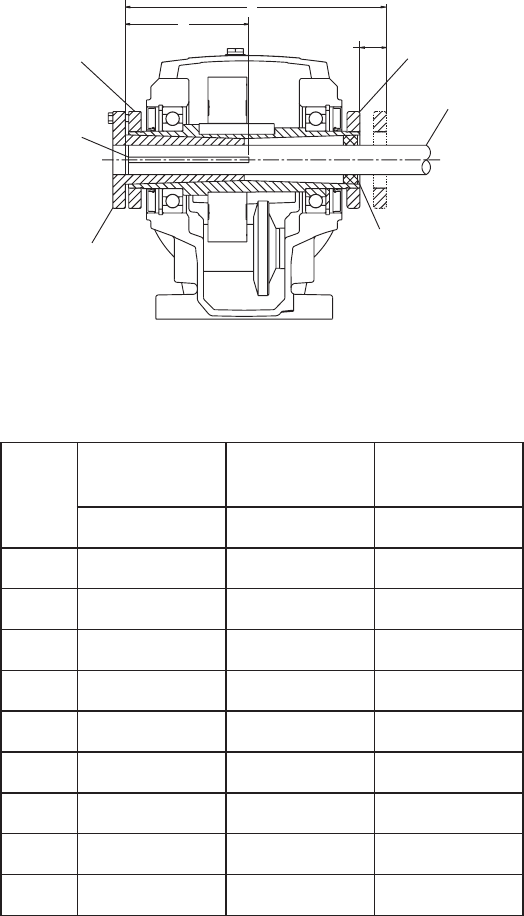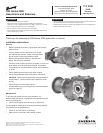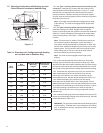
6
Stabilizer Ring
Driven
Shaft
Bushing
Driven
Shaft Key
Bushing
Ring
Endcap
MC
H
K
1.3 Mounting Conguration with Bushing Outboard
of Load
1.3.1 On the input shaft side, thread the bushing ring onto the
hollow reducer quill until the bushing ring is ush with the end of
the reducer quill shaft.
1.3.2 Place the end cap on the driven shaft with the threaded bore
facing the end of the shaft. Slide the stabilizer ring on the driven
shaft with the small end of the taper toward the end of the shaft.
1.3.3 Install Key(s)
Type 1 Bushing (2 keys):
• Install the external bushing key into the bushing as shown in
Figure 1-1 (external bushing key is supplied with the bushing kit)
• Install the driven shaft key (customer supplied) into the driven
shaft keyseat. Position the end of the driven shaft key even with
the end of the driven shaft. Retain this key to prevent movement.
1.3.4 Install Reducer
Type 1 Bushing
• Mount the reducer on the driven shaft with the bushing ring
facing outward toward the end of the driven shaft
Gear
Frame
End cap
Clearance
Minimum Shaft
Mounting
Length
Minimum Key
Connection
Length
MC H K
31 0.85 8.23 2.88
32 0.97 9.28 4.38
33
1
0.97 9.21 4.38
33A 1.03 11.16 4.63
34 1.03 11.34 4.63
35 1.21 12.23 5.63
36 1.31 16.75 6.13
37 1.44 18.08 7.38
38 1.69 18.43 7.38
1
This design is replaced by 33A design effective Jan. 2010
Figure 1-3
Table 1-3 Dimensions for Mounting Conguration
with Bushing Outboard of Load
• Locate the reducer on the driven shaft such that approximately
.50 inch of the driven shaft extends out beyond the end of the
reducer quill.
• Start the bushing (small end rst) by aligning the keyway in the
bushing with the key previously installed in the driven shaft.
• Continue moving the bushing into position and rotate the input
of the reducer as required to align the external bushing key with
the keyway in the reducer quill.
• Rotate the bushing ring clockwise to align the clearance holes
in the bushing with the threaded holes in the bushing ring. (This
will require less than 1/2 turn of the bushing ring).
• Install the bushing cap screws and hand tighten. Reposition
the reducer until the end of the driven shaft is even with the
end of the bushing ring.
• Slide the stabilizer ring into the reducer quill and thread the
end cap on hand tight.
• Tighten the bushing cap screws evenly around the bushing
ange to the recommended torque as shown Table 1.2.5. See
bolt torque specications section.
• Tighten the end cap again until hand tight. Tighten the setscrew
in the end cap to the recommended torque from Table 1.2.5.
Type 2 Bushing
• Mount the reducer on the driven shaft with the bushing ring
facing outward toward the end of the driven shaft.
• Rotate the input of the reducer as required to align the external
bushing key with the keyway in the reducer quill.
• Locate the reducer on the driven shaft such that approximately
.50 inch of the driven shaft extends out beyond the end of the
reducer quill.
• Start the bushing (small end rst) by aligning the keyway in the
bushing with the key previously installed in the driven shaft.
• Rotate the bushing ring clockwise to align the clearance holes
in the bushing with the threaded holes in the bushing ring. (This
will require less than 1/2 turn of the bushing ring).
• Install the bushing cap screws and hand tighten. Reposition
the reducer until the end of the driven shaft is even with the
end of the quill.
• Slide the stabilizer ring into the reducer quill and thread the
end cap on hand tight.
• Tighten the bushing cap screws evenly around the bushing
ange to the recommended torque as shown in Table 1.2.5.
• Tighten the end cap again until hand tight. Tighten the setscrew
in the end cap to the recommended torque from Table 1.2.5.
Note: The key length must be sufcient to engage the full length of
the bushing. The shaft must engage the full length of the reducer
shaft (Refer to “H” in Figure 1-3).
Note: There are three (3) series of bushing keys used in the
Type 2 bushing system: rectangular, square and offset. In most
cases, the key supplied will be rectangular or offset. Use caution
when installing rectangular keys as some may visually appear
square. The key should install in the bushing keyway with a sliding
type t. The key in the driven shaft keyseat should be retained
to prevent movement.
WARNING! The cap screws must thread into the bushing ring and
not the bushing. Threaded holes in the bushing are for removal
only. If assembled incorrectly, equipment failure and personal
injury may result.


















